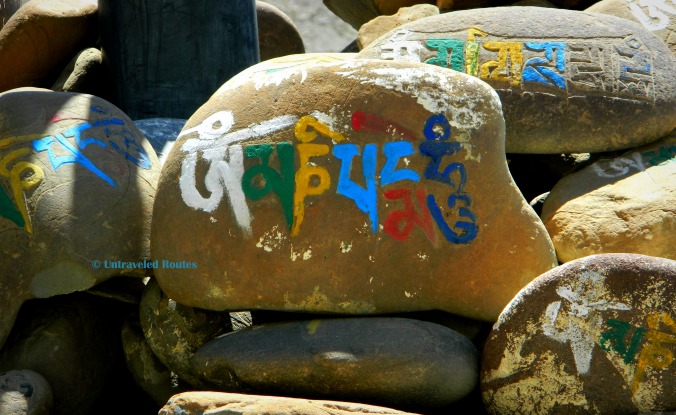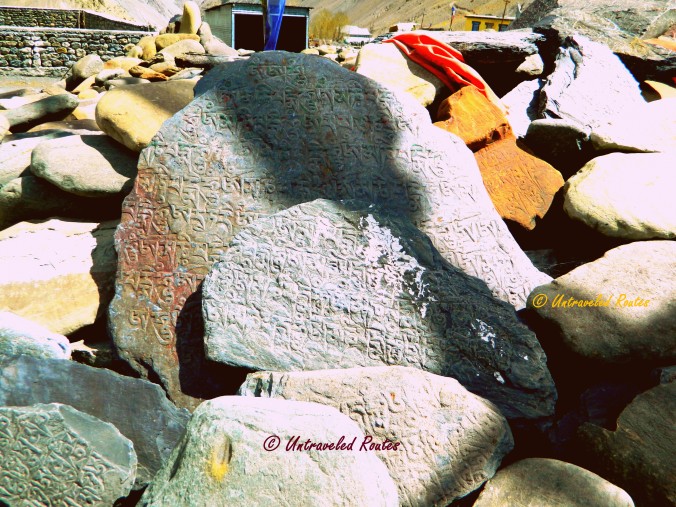The first story in this series was published few days ago and can be read here – Best of Spiti – In Pictures.
The origin of ‘Mani Stones’ is as ancient as Buddhism. Buddhists began to mark stones with symbols, phrases and mantras as a means to express their faith for deities and spread positivity. Hence, you’re likely to find varied kinds of inscriptions, use of vibrant colors manifesting belief of the decorator. These are sacred, magical and mystic.
These decorated stones make you feel not just happy but also exude positivity.


Travelers to Spiti Valley (place inhabited by Tibetans) will encounter such stones / mound of stones pretty much everywhere. Since, we were on a road trip, we spent our maximum travel time on roads and every time we saw such beautifully and meticulously carved stones, we would stop to soak in beauty.
These ‘Mani’ stones come in different colors, shapes, sizes and also different inscriptions, texts or images but primarily one will find such stones inscribed with ‘Om Mani Padme Hum’.

Fortunately, I found this profound explanation of the powerful mantra by ‘H.H Tenzin Gyatso The Fourteenth Dalai Lama of Tibet’ in the sacred texts and I’m sharing the brief version. It is believed chanting of this mantra brings great benefits for mind and soul but one must contemplate on the meaning as well for the meaning makes the chant and its impact complete.
‘Om Mani Padme Hum’
‘Decoded’

The first, OM, is composed of three pure letters, A, U, and M symbolizing the practitioner’s impure body, speech and mind. The development of pure body, speech and mind comes gradually as one transforms from leaving the impure state into the pure.
MANI, meaning jewel, symbolizes the factor of method- the altruistic intention to become enlightened, and be filled with compassion and love.
The two syllables, PADME, meaning lotus, symbolize wisdom. Just as a lotus flower grows forth from mud but is not sullied by the faults of mud, so wisdom is capable of putting you in a situation of non- contradiction where as there would be contradiction if you did not have wisdom. There is wisdom realizing impermanence or inherent existence.
Purity must be achieved by an indivisible unity of method and wisdom, symbolized by the final syllable, HUM, which indicates indivisibility. According to the sutra system, this indivisibility of method and wisdom refers to one consciousness in which there is a full form of both wisdom affected by method and method affected by wisdom. In terms of the seed syllables of the five conqueror Buddhas, HUM is the seed syllable of Akshobhya- the immovable, the unfluctuating, the one that cannot be disturbed by anything.
Thus together, the six syllables, OM MANI PADME HUM signify that in dependence on the practice which is in indivisible union of method and wisdom, you can transform your impure body, speech and mind into the pure body, speech, and mind of a Buddha. It is also believed that you should not seek for Buddhahood outside of yourself; the substances for the achievement of Buddhahood are within.

Stay enlightened. Stay Happy.


This explanation of why the I’m chanting is the best I have read …. I do ironically given that the purpose is to free, the explanations are so often over complicated. These stones are fantastic – quite stopping me in my tracks and the whole post has proven quite freeing for me.
LikeLiked by 1 person
Hi Dear,
Hope you are doing awesome. Apologies for the delayed reply!
The very first time I saw the inscription, it was the mountain visible from Tabo village, I couldn’t refrain and had to ask the locals about it and they explained about the mantra and stones. Later, as we continued our journey, I could spot stones at places least expected, it was just a beautiful experience and I believe a great way to spread positivity.
Thank you so much for your continued feedback 🙂
LikeLiked by 1 person
Fabulous, I like the way you have explained each syllable. Many times we just chant mantras without knowing what they essentially mean, but knowing them gives them the right due.
LikeLiked by 1 person
Thank you, Alok.
How have you been?
I’m so glad that I could find such explanation and spread the positive message :). Knowing the meaning and consciously chanting makes a lot of difference.
Good day.
LikeLiked by 1 person
All is good here, Charu. Hope you are enjoying too 😊
LikeLiked by 1 person
I’d never heard of these stones. Gorgeous. It must have felt amazing to be around them!!! Thank You and Cheers! 🙂
LikeLiked by 1 person
Thank you so much.
It’s one of the most beautiful things I have come across, a rock art in simple language but creating great impact.
Good day. 🙂
LikeLiked by 1 person
Beautiful pictures and enchanting description of each and every image !!
LikeLiked by 1 person
Thank you for your positive feedback 🙂
LikeLiked by 1 person
My pleasure 😇
LikeLiked by 1 person
So interesting to read this post. I have not heard of mani stones before. We live in Sri Lanka which has a population of primarily Buddhists, yet the type of Buddhism practiced here is Theravada Buddhism. We have written a few posts covering our first learning of Buddhism. The stones, especially the carved ones, are very beautiful. Thanks for sharing.
Peta
LikeLiked by 1 person
Thank you for bringing up ‘Theravada Buddhism’. I didn’t know much about it but now I will find out 🙂 The first thing I’ll do is read your insightful posts on the topic.
The stones I believe are peculiar to Tibetan community as I have seen such in Tibet too. And the region Spiti Valley is primarily inhabited by Tibetan refugees in India.
Good day.
LikeLike
I’m glad that you have noticed these stones. I have come across so many travelogues to Spiti but people normally write about the flags. Love the art in these stones. Thanks for posting for all of us!
LikeLiked by 1 person
Thank you Arvind!
How have you been?
That’s a great observation, mostly people focus on flags but stones as integral and important part of Tibetan culture as Flags are.
Good Day, Charu
LikeLiked by 1 person
Charu, I’m doing okay. I think you are observant which is why you wrote about stones. 🙂
Do you guys travel every month?
LikeLiked by 1 person
Great post ! Thanks for taking me to Spiti valley !!
LikeLiked by 1 person
Enlightened as it can be. 🙂
LikeLiked by 1 person
So interesting! I`ve never heard about it before thanks so much for sharing. Great post as always 🙂
LikeLiked by 1 person
Thank you for your continued support Caroline 🙂
LikeLiked by 1 person
You are very welcome! 🙂
LikeLiked by 1 person
Never heard about Mani stones before. Thanks for sharing!
LikeLiked by 1 person
I’m glad I could share 🙂 Thank you
LikeLike
This is so beautiful!!!!
LikeLiked by 1 person
Thank you for your kind comment☺️
LikeLiked by 1 person
You’re welcome. Will keep reading!
LikeLiked by 1 person
I love those Mani stones and your backstory. Thank you. May all beings know peace and happiness.
LikeLiked by 1 person
Thank you so much!! Glad to see your comment.
And AMEN 🙂
LikeLiked by 1 person
I enjoyed my visit thoroughly!
LikeLiked by 1 person
I have turned my attention only very recently, started reading books and joined a group, and since then I feel my outlook on this world and life has changed. Yes, wisdom and purity needs to be found inside…
Thank you for this incredibly inspiring post! (And for those amazing photos!)
🤗🤗🤗
LikeLiked by 1 person
I’m glad you’re on the path of rediscovery 😇 Till I visited Spiti I wasn’t too aware either, though I have been to Dharamshala and McLeod, and the Tibetan culture always intrigued me but Spiti totally changed my perspective ☺️.
LikeLiked by 1 person
It’s the most life -changing thought /spirituality experience ever… 🤗
LikeLiked by 1 person
Beautiful and peaceful. Thanks for sharing such beautiful photos. 🙂
LikeLiked by 1 person
Fascinating.
LikeLiked by 1 person
Thank you! Indeed it is.
LikeLike
Interesting !!
LikeLiked by 1 person
Your life is really cool! How often do you travel?
LikeLiked by 1 person
Thank you ☺️. An endeavour to add a different perspective and gain as much experience as possible. We try to cover new location every quarter. Sometimes the plan works well, sometimes Life keeps us busy.
LikeLike
The best ever life , I guess!👍👍
LikeLiked by 1 person